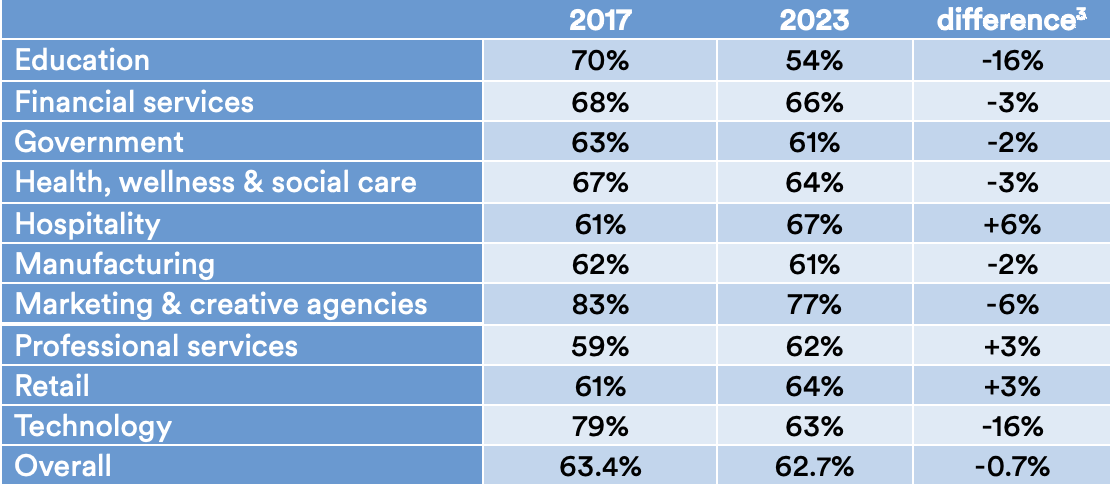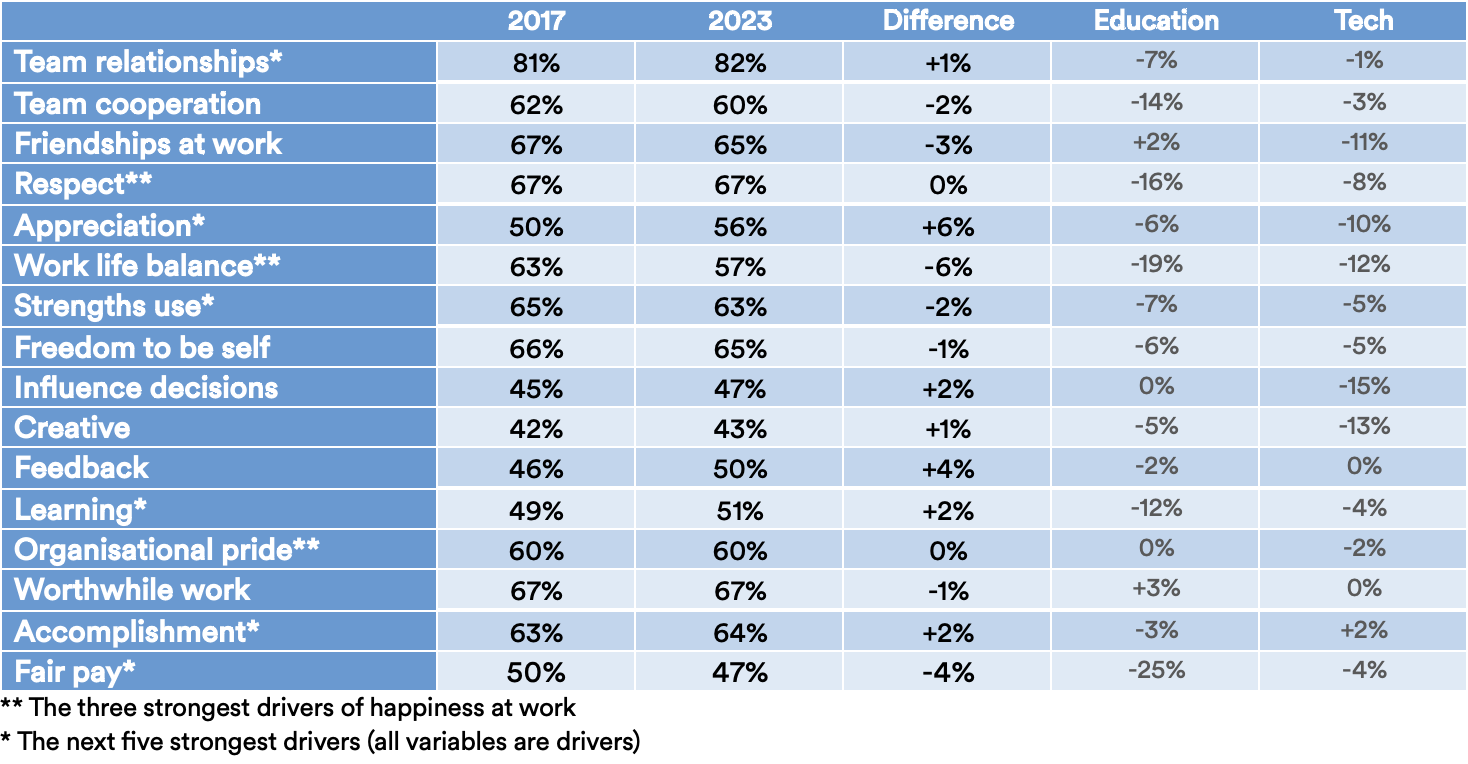To answer this question, we conducted a survey to see how happiness at work has changed. We used the same questions as a survey we did in 2017, so that we could directly compare the results.
What did the survey find?
Perhaps surprisingly, we found that overall happiness at work levels were very stable, with 62.7% of people reporting that they were happy at work in 2023 compared to 63.4% in 2017.
However, the top line averages hide a lot of changes underneath, with the Education and Technology sectors seeing large falls in happiness whereas Hospitality showed an improvement.

The large falls in the Education and Tech sectors are at least in part due to specific 2023 challenges. School teachers in the UK have been taking strike action, which obviously reflects a deep underlying unhappiness. Whereas the Tech sector has faced a different challenge, large wave of redundancies which will have been very unsettling to everyone. However, as job openings are still strong in the sector the redundancies alone are unlikely to explain such a large drop.
Changes in happiness levels act a bit like a good-bad signal- drawing our attention to an issue that needs addressing. But the signal can’t tell us why the change has happened. For that you need to look at the underlying drivers of happiness at work. The table below shows what proportion of people were happy or very happy across 16 drivers of happiness at work and the changes seen in these. These show in much more detail what is driving the changes in happiness at work, both across the years and in these two particular sectors.

Across the whole of the UK, the biggest drops were in work-life balance, fair pay, and friendships at work. Fair pay is not surprising with the cost-of-living crisis; however, work-life balance may surprise some people, as working from home has become so much more prevalent. We have seen this change in our client data for some time now, and it seems that for many, the boundary between work and home has become blurred. If you are working from home regularly it can be more difficult to leave work behind at the end of the day. On the other hand, the fact that people are generally feeling a bit more appreciated at work is to be welcomed.
Looking in more detail at the Education and Tech sectors is very revealing though.
Given the industrial action it is perhaps not surprising that in the Education sector there is the feeling that people are not paid fairly, but there are also very large falls in work-life balance and respect. Both work-life balance and respect are very important drivers of happiness at work and so large drops are even more troublesome.
For people working in the Tech sector, the malaise seems to be of a different cause. They seem to feel more cut off with less influence, lower creativity, and fewer friendships. They are also the sector that has most embraced remote working, with over 40% of people working fully remote compared to less than 15% pre-pandemic. This large change may well have inadvertently undermined some of the more human interactions which are critical for team bonding, with knock on effects on creativity, collaboration, and staff retention.
Drivers and Outcomes
Looking at the data this way illustrates a very important feature of good survey design – the need to create separate indicators of drivers and outcomes (means and ends). Happiness at work, in this instance, is the outcome measure – it is the desirable end that we are seeking to achieve. All the drivers meanwhile are means to that end. By having separate indicators for them we can understand their relationship much more clearly.
At Friday Pulse we track team happiness weekly, as it is so important to pick up that good-bad signal in real time. That way organisations can respond to any issues that need addressing. We complement the weekly outcome measure with a quarterly pulse survey on the drivers. So, in a similar way that it is easy to see that the Education and Tech sectors have different issues to address, different businesses face different challenges. In fact, the specificity of challenges varies team by team, as whenever I look at client data, I always see a lot of variation between teams.
In fact, this is the one thing that, as a statistician, I really dislike about the Gallup Q12 engagement survey. There is no separate outcome indicator. Instead, engagement is simply defined as the average of the 12 questions. As well as making it impossible to track engagement weekly (as no one would answer 12 questions every week!), it also totally misses that in different circumstances, different drivers have different impacts on happiness levels.
For example, in our data I can see that fair pay has become significantly more important to people’s happiness at work in 2023 than it was in 2017. This makes total sense as we have high levels of inflation and a cost-of-living crisis. But the Gallup approach simply wouldn’t be able to identify these changes. Interestingly, another driver that has increased in strength is organisational pride. This means that feeling that your organisation is worth working for is becoming more important to people, probably as part of a long-term trend towards more responsible ways of doing business.
Five Ways to Happiness at Work
At Friday Pulse we call these drivers the Five Ways to Happiness at Work:
Connect … Be Fair … Empower … Challenge … Inspire …
There are three questions about each of them, in the table these are presented in order, with the first three about Connect, the next three about Be Fair etc .
They are all important drivers and are designed to be easy to understand and implement at a team level. But they can also be thought of higher-level drivers and a regression model shows that the two strongest influencers are Be Fair and Inspire.
What this means, if we were to put words into the mouth of a typical UK worker, then their plea would be:
Treat me fairly and inspire me.
If organisations can get these two right, then they are on a good path to building a happy and successful business.
Nic Marks, CEO and Founder of Friday Pulse Ltd.
Friday Pulse uniquely tracks the weekly happiness of teams. Every quarter we also ask 15 questions about the key drivers of happiness at work, which we call the Five Ways to Happiness at Work. Book a demo to find out more.





